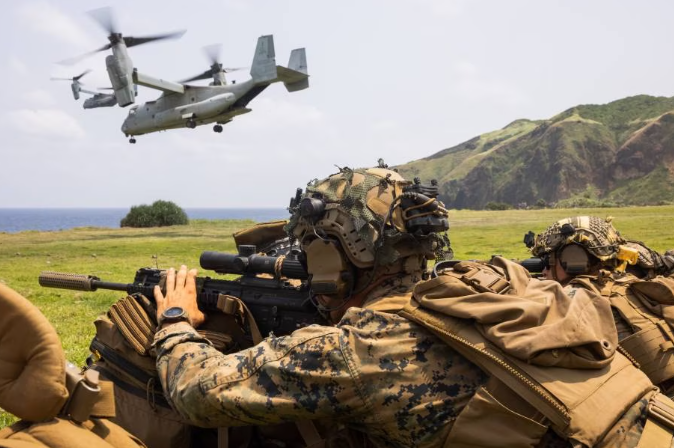The American people and a growing number of elected representatives are beginning to suspect something some Marine Corps leaders have been unwilling to admit: United States Marines are no longer capable of responding to global crises and contingencies quickly and effectively, and in some cases, at all.
During February 2022, the Marine Corps was unable to meet a U.S. European Command request to surge a Marine expeditionary unit — a force of about 2,200 specially trained Marines and sailors embarked on amphibious ships — to the Mediterranean in response to Russia’s invasion of Ukraine, Lt. Gen. Karsten Heckl, the deputy commandant for Combat Development and Integration, told the Senate Armed Services seapower subcommittee. A month would pass before a Marine expeditionary unit could sail from North Carolina.
A year later, the Marines were unable to send a large disaster relief force to Turkey after a devastating earthquake, the commandant confirmed.
Again, there were no embarked Marines aboard amphibious ships in the region. The best the Marines could do was send a small detachment of 34 Marines by air.
According to some estimates, another 16,000 Americans were left to fend for themselves, “a startling break with American precedent,” contributing writer and Marine veteran Elliot Ackerman wrote in The Atlantic. Once again, there were no Marine expeditionary forces either afloat or ashore that could respond to time-sensitive requirements of regional military commanders.
In all three of these cases, Marine leadership identified the lack of available amphibious shipping as the main reason for the absence of forward-deployed Marine forces.
However, the leaders failed to mention that during 2021 and 2022 the Marine Corps had ended the rotational deployments of three forward based special purpose Marine air-ground task forces, focused on crisis response missions in the Southern Command, Africa Command and Central Command areas.
These events suggest a disturbing trend that should alarm those entrusted with our national defense and beg the question: How capable are the Navy and Marine Corps to answer a 9-1-1 call for future military and humanitarian emergencies?
Timely and effective global response across the spectrum of conflict requires a combination of amphibious lift for forward presence, maritime prepositioning for rapid deployment and sustainment, and a combined arms force that can be task organized for everything from humanitarian assistance and disaster relief to major combat against a determined enemy. Neither the Navy nor the Marine Corps can meet these essential requirements today.
The two services have dramatically reduced the nation’s requirement for amphibious ships, emasculated the maritime prepositioning force and dangerously crippled the combined arms capabilities of the Marine air-ground task forces.
Progress toward that goal from a nadir of 28 ships in 2010 was slow, but steady.
Yet, in 2019, the commandant of the Marine Corps unilaterally abandoned this requirement. Only after the Navy announced its own questionable intentions to dramatically reduce the size and composition of the fleet did the Marine Corps feel compelled to articulate a “new” minimum requirement for 31 ships.
Given the current historically low operational readiness rate of the amphibious fleet, the Marines are often unable to continuously project two U.S.-based Marine expeditionary units forward in the Mediterranean and Indo-Pacific areas.
Each of these squadrons supported a fly-in Marine expeditionary brigade (16,500 Marines and sailors) for 30 days of combat.
Today, the Mediterranean squadron has been deactivated and the other two squadrons are being reduced to four and three ships respectively and being reconfigured to support a smaller Marine force.
Had the Mediterranean squadron still existed, a Marine task force could have quickly flown to Turkey, “married up” with supplies and equipment from the ships, and provided a meaningful contribution to the earthquake relief effort. Prepositioning capability has been so severely truncated that it now may be irrelevant.
Four years ago, the Marine Corps was the world’s premier expeditionary, combined arms force. Marines could be task organized for any crisis or contingency, and immediately deployed anywhere.
They were scalable, capable of rapidly converging and building from small units to a corps-size force. They were expeditionary, able to sustain themselves until follow-on reinforcements (if needed) arrived.
Today, the Marine Corps has or will cut 21% of Marines in infantry battalions, all tanks and bridging, 67% of direct support cannon artillery, most rapid and in-stride breaching and proofing capabilities, almost 30% of tactical aviation, and much organic logistical support. Simply stated, Marines can no longer be effectively task organized for crises and contingencies “in every clime and place.”
Marine Corps leaders are being disingenuous when they tell Congress and the American people that the Marine Corps is the nation’s 9-1-1 force, fully capable of responding to crises and contingencies across the spectrum of conflict and in every “clime and place.” It no longer is and the Navy shares much of the blame.
The Navy-Marine Corps team is now a shell of the capacity that served our maritime nation so effectively for over two centuries.
Until Marines are properly supported with adequate amphibious ships, bolstered by a robust maritime prepositioning force and restored to a true combined arms force, they will remain incapable of fulfilling the will of the 82nd Congress: “to be most ready when the nation is generally least ready.”
Gen. James Conway (retired) is a career infantry officer with extensive experience in global response operations. He was the operations officer for the 31st Marine Amphibious Unit during contingency operations in Beirut, commanded Battalion Landing Team 3/2 during Operations Desert Shield and Desert Storm, and commanded I Marine Expeditionary Force during two consecutive combat tours in Iraq. His last assignment was 34th commandant of the Marine Corps.
Gen. Anthony Zinni (retired) is a career infantry officer with extensive experience in global response operations. He commanded the 35th Marine Expeditionary Unit, which was deployed twice to the Philippines to conduct emergency security operations and disaster relief operations. He also served as the director of operations for the Unified Task Force in Somalia for Operation Restore Hope. His last assignment was commander, United States Central Command.





